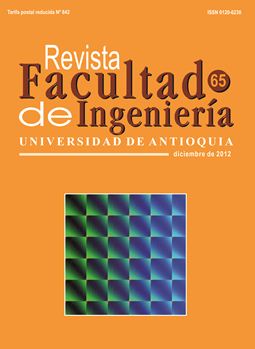Controller design for a flyback coverter in operating interconnected to grid mode, for photovoltaic applications
DOI:
https://doi.org/10.17533/udea.redin.14172Keywords:
microinverter, photovoltaic panel, flyback converterAbstract
This article presents the modeling of a flyback converter integrated in a two-stage photovoltaic microinverter with grid connection, and the design of the respective controllers. The idea is to obtain the dynamic modeling of the DC / DC converter in order to implement a type of control that allows it to operate as a current source and in turn allows to regulate the input voltage, based on the signal resulting from the location point algorithm. maximum power. This control scheme is novel and has been documented by some authors using boost type converters. Therefore, the great contribution of this article lies in the use of this novel scheme to take advantage of the maximum energy coming from the panels, using a converter that has the characteristic of galvanically isolating the generation from the rest of the circuit. To validate the operation of the flyback under study, simulations were carried out in PSIMTM. Finally, the conclusions are presented.
Downloads
References
Y. Ruan, Q. Liu, W. Zhou, R. Firestone, W. Gao, T. Watanabe. “Optimal option of distributed generation technologies for various commercial buildings”. Applied Energy. Vol. 86. 2009. pp. 1641-1653. DOI: https://doi.org/10.1016/j.apenergy.2009.01.016
P. Mancarella, G. Chicco. “Global and local emission impact assessment of distributed cogeneration systems with partial-loads models”. Applied Energy. Vol. 86. 2009. pp. 2096-2106. DOI: https://doi.org/10.1016/j.apenergy.2008.12.026
G. Bakos. “Distributed power generation: A case study of small scale PV power plant in Greece”. Applied Energy. Vol. 86. 2009. pp. 1757-1766. DOI: https://doi.org/10.1016/j.apenergy.2008.12.021
C. Trujillo, D. Velasco de la Fuente, G. Garcera, E. Figueres, J. Guacaneme. “Reconfigurable control scheme for a PV microinverter working in both grid connected and island modes”. IEEE Transactions on Industrial Electronics. No. 99. 2011. pp. 1-11. DOI: https://doi.org/10.1109/ISIE.2011.5984378
F. Zia, K. Salim, N. Yousuf, R. Haider, M. Alam. Design and implementation of a single phase grid tie photovoltaic inverter. International Conference on the Developments in Renewable Energy Technology (ICDRET). Blangadesh, Dhaka. 2012. pp. 1-4.
N. Femia, G. Petrone, G. Spagnuolo, M. Vitelli, “Optimization of perturb and observe maximum power point tracking method”. IEEE Transactions on Power Electronics. Vol. 20. 2005. pp. 963-973. DOI: https://doi.org/10.1109/TPEL.2005.850975
X. Weidong, W. Dunford, P. Palmer, A. Capel. “Regulation of Photovoltaic Voltage”. IEEE Transactions on Industrial Electronics. Vol. 54. 2007. pp.1365-1374. DOI: https://doi.org/10.1109/TIE.2007.893059
D. Petreus, T. Patarau, S. Daraban, C. Morel, B. Morley. “A novel máximum power point tracker based on analog and digital control loops”. Solar Energy. Vol. 85. 2011. pp. 588-600. DOI: https://doi.org/10.1016/j.solener.2011.01.005
Guía de usuario PSIM 7.0. Powersim Inc. 2006. Consultado en Septiembre de 2012. Disponible en: http://www.powersimtech.com/index.php?name=login&nextpage=manuals.
C. Trujillo. Concepción de controladores reconfigurables para microinversores fotovoltaicos operando como unidades autónomas de generación de energía en microrredes. Tesis Doctoral. Universidad Politécnica de Valencia. España. 2011. p. 244.
H. Chiu, H. Huang, H. Yang, H. Cheng. “An improved single-stage flyback PFC converter for high luminance lighting LED lamps”. International Journal of Circuit Theory and Applications. Vol. 36. 2008. pp. 205-210. DOI: https://doi.org/10.1002/cta.404
T. Esram, P. Chapman. “Comparison of Photovoltaic Array Maximum Power Point Tracking Techniques”. IEEE Transactions on Energy Conversion. Vol. 22. 2007. pp. 439-449. DOI: https://doi.org/10.1109/TEC.2006.874230
D. Sable, R. Ridley. “Comparison of performance of single-loop and current-injection control for PWM converters that operate in both continuous and discontinuous modes of operation”. IEEE Transactions on Power Electronics. Vol. 7. 1992. pp.136-142.
M. Villalva, E. Ruppert. Input-controlled buck converter for photovoltaic applications: Modelling and design. IEEE Conference on Power Electronics, Machines and Drives. York, United Kingdom. 2008. pp. 505-509. DOI: https://doi.org/10.1049/cp:20080573
V. Vorperian. “Simplified analysis of PWM converters using model of PWM switch. Continuous conduction mode”. IEEE Transactions on Aerospace and Electronic Systems. Vol. 26. 1990. pp. 490-496. DOI: https://doi.org/10.1109/7.106126
D. Sable, R. Ridley, B. Cho. “Comparison of performance of single-loop and current-injection control for PWM converters that operate in both continuous and discontinuous modes of operation”. IEEE Transactions on Power Electronics. Vol. 7. 1992. pp. 136-142. DOI: https://doi.org/10.1109/63.124586
Downloads
Published
How to Cite
Issue
Section
License
Copyright (c) 2018 Revista Facultad de Ingeniería

This work is licensed under a Creative Commons Attribution-NonCommercial-ShareAlike 4.0 International License.
Revista Facultad de Ingeniería, Universidad de Antioquia is licensed under the Creative Commons Attribution BY-NC-SA 4.0 license. https://creativecommons.org/licenses/by-nc-sa/4.0/deed.en
You are free to:
Share — copy and redistribute the material in any medium or format
Adapt — remix, transform, and build upon the material
Under the following terms:
Attribution — You must give appropriate credit, provide a link to the license, and indicate if changes were made. You may do so in any reasonable manner, but not in any way that suggests the licensor endorses you or your use.
NonCommercial — You may not use the material for commercial purposes.
ShareAlike — If you remix, transform, or build upon the material, you must distribute your contributions under the same license as the original.
The material published in the journal can be distributed, copied and exhibited by third parties if the respective credits are given to the journal. No commercial benefit can be obtained and derivative works must be under the same license terms as the original work.










 Twitter
Twitter